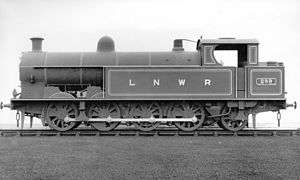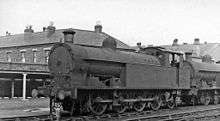LNWR 1185 Class
The LNWR 1185 Class was a class of 0-8-2T steam tank locomotives designed by Charles Bowen-Cooke and introduced in 1911. They passed into LMS ownership in 1923 and 8 survived to British Railways ownership in 1948. British Railways numbers were 47875-47896 (with gaps).
| LNWR 1185 Class | |||||||||||||||||||||||||||||||||||||||||||||||
|---|---|---|---|---|---|---|---|---|---|---|---|---|---|---|---|---|---|---|---|---|---|---|---|---|---|---|---|---|---|---|---|---|---|---|---|---|---|---|---|---|---|---|---|---|---|---|---|
 No. 289 in photographic grey livery | |||||||||||||||||||||||||||||||||||||||||||||||
| |||||||||||||||||||||||||||||||||||||||||||||||
| |||||||||||||||||||||||||||||||||||||||||||||||
| |||||||||||||||||||||||||||||||||||||||||||||||
| |||||||||||||||||||||||||||||||||||||||||||||||
Career
30 engines, designed under the supervision of C J Bowen-Cooke, and built at Crewe during 1911-1917. Intended for duties formerly needing two locomotives. Essentially a tank version of the G class 0-8-0s. When introduced they had the then new style of 12″ letters for the company's initials on the tank sides. They were fitted with saturated "Precursor" class boilers with lagged ends, round-top fireboxes, and sloping coal bunkers.[4] The main wheels were coupled by three overlapping rods and the third pair of wheels were flangeless. Lever actuated Joy reversing gear appeared in-lieu of the normal Ramsbottom screw system. The earlier engines initially had slender tapered Cooke buffers but these were replaced by those of standard Webb pattern: The latter type was fitted from new on later engines. Braking was by steam, but vacuum brakes were provided to operate fitted or passenger stock if required.[1]
| LNWR No. | Crewe Works No. | Build date[6] | LMS No.[lower-alpha 1] | Withdrawn[6] | Notes |
|---|---|---|---|---|---|
| 1185[3][4] | 5040 | December 1911 | 7870 | December 1945 | |
| 1665[4] | 5041 | December 1911 | 7872 | October 1936 | |
| 1548[4][7] | 5042 | December 1911 | 7871 | May 1935 | Briefly No.1790. |
| 289[8] | 5043 | January 1912 | 7873 | January 1935 | |
| 1163[8] | 5044 | January 1912 | 7874 | June 1935 | |
| 1494[8] | 5045 | January 1912 | 7875 | August 1948 | |
| 1592[8] | 5046 | January 1912 | 7876 | July 1947 | |
| 1659[8] | 5047 | January 1912 | 7877 | February 1953 | [lower-alpha 2] |
| 1663[7] | 5048 | January 1912 | 7878 | June 1947 | |
| 2013[7] | 5049 | February 1912 | 7879 | December 1936 | |
| 58 | 5247 | August 1915 | 7882 | October 1934 | |
| 482 | 5248 | August 1915 | 7880 | March 1937 | |
| 563 | 5249 | August 1915 | 7881 | July 1951 | [lower-alpha 2] |
| 736 | 5250 | August 1915 | 7883 | March 1935 | |
| 1090 | 5251 | September 1915 | 7884 | June 1951 | [lower-alpha 2] |
| 1124 | 5252 | September 1915 | 7885 | March 1950 | |
| 1414 | 5253 | September 1915 | 7886 | September 1948 | |
| 1514 | 5254 | September 1915 | 7887 | August 1948 | |
| 1515 | 5255 | September 1915 | 7888 | December 1948 | |
| 2277 | 5256 | September 1915 | 7889 | October 1934 | |
| 24 | 5357 | December 1916 | 7890 | June 1939 | |
| 92 | 5358 | December 1916 | 7891 | June 1946 | |
| 714 | 5359 | January 1917 | 7892 | February 1948 | |
| 1291 | 5360 | January 1917 | 7893 | October 1934 | |
| 1331 | 5361 | January 1917 | 7894 | September 1939 | |
| 2105 | 5362 | January 1917 | 7895 | October 1934 | |
| 2294 | 5363 | January 1917 | 7896 | November 1950 | [lower-alpha 2] |
| 2341 | 5364 | February 1917 | 7897 | June 1946 | |
| 2348 | 5365 | February 1917 | 7898 | January 1946 | |
| 2391 | 5366 | February 1917 | 7899 | August 1935 |
- LMS numbers were applied piecemeal during 1925–1928 but not in the same sequence as construction.
- Only these engines ever carried their post-1947 numbers [adding 40000 to those of the LMS].

During the Depression years many of the class spent time in store for want of work and almost half were scrapped. Ten, however, survived to be taken into nationalised stock at the start of 1948.[9]
No.1090, as BR No.47884, achieved the highest calculated service mileage of 732,425 miles. Others ran 715,830 miles (No.47896), 701,005 miles (No.47877), 692,706 miles (No.47881) and 553,433 miles (No.7885).[9]
References
- Talbot, Edward (1984). An Illustrated History of LNWR Engines. Oxford Publishing.CS1 maint: ref=harv (link)
- H C Casserley & S W Johnson (1966). Locomotives At The Grouping No.3 London Midland and Scottish. Ian Allan.
- The Locomotive Magazine and Railway Carriage and Wagon Review, 15 December 1911
- The Locomotive Magazine and Railway Carriage and Wagon Review, 15 January 1912
- Baxter 1979, pp. 301–302.
- Baxter 1979, p. 302.
- The Locomotive Magazine and Railway Carriage and Wagon Review, 15 March 1912
- The Locomotive Magazine and Railway Carriage and Wagon Review, 15 February 1912
- Talbot, Edward (2002). The London & North Western Railway Eight-Coupled Goods Engines. ISBN 978-0-9542787-0-0.CS1 maint: ref=harv (link)
- Baxter, Bertram (1979). Baxter, David (ed.). British Locomotive Catalogue 1825–1923, Volume 2B: London and North Western Railway and its constituent companies. Ashbourne, Derbyshire: Moorland Publishing Company. pp. 301–302. ISBN 0-903485-84-2.
- Casserley, H. C. & Johnston, Stuart W. (1974) [1966]. Locomotives at the Grouping 3: London, Midland and Scottish Railway. Shepperton, Surrey: Ian Allan. ISBN 0-7110-0554-0.
- Talbot, Edward (2002). The London & North Western Railway Eight-Coupled Goods Engines. ISBN 978-0-9542787-0-0.CS1 maint: ref=harv (link)
Further reading
- Tuplin, W. A. (1963). North Western Steam. George Allen & Unwin.CS1 maint: ref=harv (link)
External links
| Wikimedia Commons has media related to LNWR 1185 Class. |